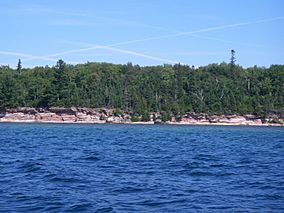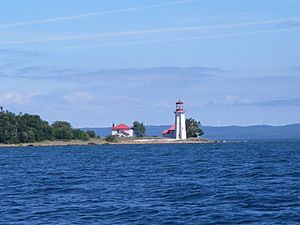Ile Parisienne facts for kids
Ile Parisienne is a special island in Ontario, Canada. It's not a place where people live, so it's called an "uninhabited" island. You can find it in Whitefish Bay, which is part of the huge Lake Superior.
The island's name, "Ile Parisienne," comes from the French language. It means "Parisian island," like something from the city of Paris!
At the very southern tip of the island, there's an important building called the Ile Parisienne Light. This lighthouse helps ships find their way safely through a busy shipping route on Lake Superior. It's like a traffic light for boats! In 1991, this lighthouse was recognized as a special Federal Heritage Building because of its history and importance. People are also trying to get it named a Heritage Lighthouse of Canada.
A special area called the Ile Parisienne Conservation Reserve was created in 2001. Its job is to protect the island's amazing natural features, like its unique rocks, plants, and animals.
Contents
About Ile Parisienne Conservation Reserve
Quick facts for kids Ile Parisienne Conservation Reserve |
|
|---|---|
|
IUCN Category II (National Park)
|
|

Ile Parisienne sandstone cliffs on Western side
|
|
| Location | Whitefish Bay, Ontario, Canada |
| Nearest city | Sault Ste. Marie, Ontario |
| Area | 911 ha (2,250 acres) |
| Established | 2001 |
| Governing body | Ministry of Natural Resources |
Ile Parisienne is located on the eastern side of Lake Superior. It sits in the middle of Whitefish Bay. The island is about 25 km (16 mi) northwest of Sault Ste. Marie, Ontario.
The island covers an area of 911 hectares (2,250 acres). It is about 8 km (5.0 mi) long from north to south. At its widest point, it is about 1.6 km (0.99 mi) across.
Why Ile Parisienne is Protected
The Ile Parisienne Conservation Reserve was created in 2001. This was done by the Ontario Public Lands Act. The main goal is to protect the entire island.
Almost all of the island is part of this protected area. There are only two small parts that are not included. One is a 46 ha (110 acres) piece of land at the southeast end that is privately owned. The other is the southwest end where the lighthouse is located.
The reserve also includes a special water zone. This zone extends 1.6 km (0.99 mi) out from the island's shore into Whitefish Bay. This helps protect the waters around the island too.
Island Geology and Wildlife
The island has very old rocks called Jacobsville Sandstone. These rocks formed a very long time ago, in the Precambrian era. You can see these rocks sticking out of the ground.
The island also has sandy beaches that were formed after the last ice age. There are sand dunes with plants growing on them. You can also find unique areas with many large rocks.
The reserve is important for many animals. It protects places where lake trout and whitefish lay their eggs. It also provides homes for waterfowl (like ducks and geese), raptors (like eagles and hawks), and migrating birds. These birds use the island for feeding, nesting, and raising their young.
The island has different types of wetland areas. It also has very tall, old trees. These include white pine, black spruce, balsam fir, and white birch. Some of these trees are so old and tall they are almost like an "old-growth forest."
Managing the Reserve
The Ontario Ministry of Natural Resources manages the Ile Parisienne Conservation Reserve. This means they are in charge of making sure the island stays protected.
There are no roads on the island for cars or trucks. People are not allowed to use the land for private or business purposes. No special permits have been given out for land use.
Scientists are encouraged to do research on the island. This research must be done by qualified people or groups. Any new plans for how the land is used must pass a "Test of Compatibility." This test makes sure the plans fit with the rules for Crown Land Use.
In 2010, the government agency Fisheries and Oceans Canada said that almost 1000 Canadian lighthouses were no longer needed. This was under a new law called the Heritage Lighthouse Protection Act. However, people asked for the Ile Parisienne Light to be named a Heritage Lighthouse of Canada by May 29, 2015. This would help protect it for the future.


